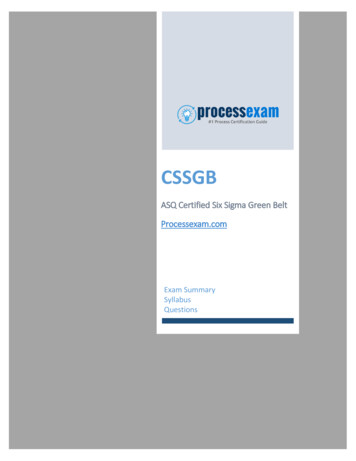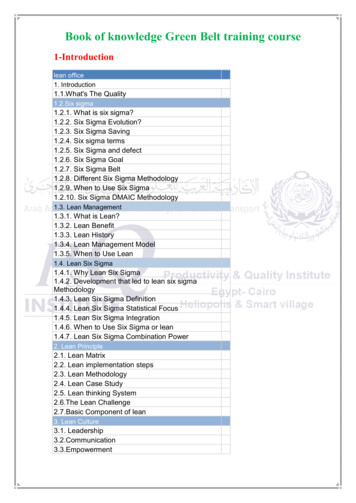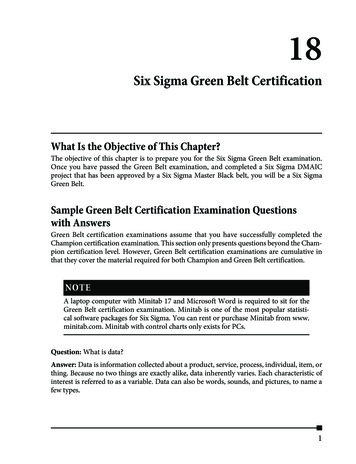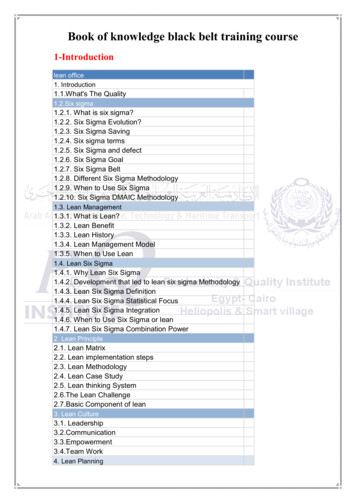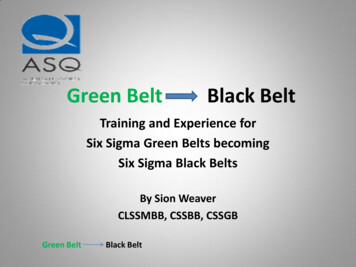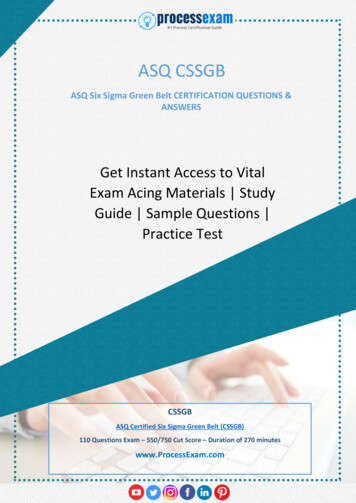
Transcription
ASQ CSSGBASQ Six Sigma Green Belt CERTIFICATION QUESTIONS &ANSWERSGet Instant Access to VitalExam Acing Materials StudyGuide Sample Questions Practice TestCSSGBASQ Certified Six Sigma Green Belt (CSSGB)110 Questions Exam – 550/750 Cut Score – Duration of 270 minuteswww.ProcessExam.com
CSSGB Exam QuestionsTable of ContentsDiscover More about the CSSGB Certification . 2ASQ CSSGB Six Sigma Green Belt Certification Details:. 2CSSGB Syllabus: . 3I. Overview: Six Sigma and the Organization (13 Questions) . 3II. Define Phase (23 Questions) . 3III. Measure Phase (23 Questions) . 6IV. Analyze Phase (15 Questions) . 7V. Improve Phase (15 Questions). 7VI. Control Phase (11 Questions) . 8Broaden Your Knowledge with ASQ CSSGB SampleQuestions: . 8Avail the Study Guide to Pass ASQ CSSGB Six SigmaGreen Belt Exam: . 11Career Benefits: . 12ASQ Six Sigma Green Belt Certification Practice Exam1
CSSGB Exam QuestionsDiscover More about the CSSGB CertificationAre you interested in passing the ASQ CSSGB exam? First discover, whobenefits from the CSSGB certification. The CSSGB is suitable for a candidateif he wants to learn about Business Process Improvement. Passing the CSSGBexam earns you the ASQ Certified Six Sigma Green Belt (CSSGB) title.While preparing for the CSSGB exam, many candidates struggle to get thenecessary materials. But do not worry; your struggling days are over. TheCSSGB PDF contains some of the most valuable preparation tips and thedetails and instant access to useful CSSGB study materials just at one click.ASQ CSSGB Six Sigma Green Belt CertificationDetails:Exam NameASQ Certified Six Sigma Green BeltExam CodeCSSGBExam FeeUSD ASQ MEMBERS - 338NON-MEMBERS - 438RETAKES - 238Exam Duration270 MinutesNumber ofQuestions110Passing Score550/750FormatMultiple Choice QuestionsCertified Six Sigma Green Belt Certification PreparationBooks / Trainings The Certified Six Sigma Green Belt Handbook, SecondEditionSchedule ExamBook Your ExamSample QuestionsASQ Six Sigma Green Belt Exam Sample Questions andAnswersPractice ExamASQ Certified Six Sigma Green Belt (CSSGB) PracticeTestASQ Six Sigma Green Belt Certification Practice Exam2
CSSGB Exam QuestionsCSSGB Syllabus:I. Overview: Six Sigma and the Organization (13 Questions)1. Value of Six Sigma- Recognize why organizations use Six Sigma, how they apply itsphilosophy and goals, and the evolution of Six Sigma from qualityleaders such as Juran, Deming, Shewhart, Ishikawa, and others.(Understand)2. Organizational goals and Six Sigma projectsA. Six Sigma and - Identify the linkages and supports that need to be establishedbetween a selected Six Sigma project and the organization’sOrganizationalgoals, and describe how process inputs, outputs, and feedback atGoalsall levels can influence the organization as a whole. (Understand)3. Organizational drivers and metrics- Recognize key business drivers (profit, market share, customersatisfaction, efficiency, product differentiation) for all types oforganizations. Understand how key metrics and scorecards aredeveloped and how they impact the entire organization.(Understand)1. Lean concepts- Define and describe lean concepts such as theory of constraints,value chain, flow, and perfection. (Apply)B. LeanPrinciples in the 2. Value stream mapping- Use value stream mapping to identify value-added processes andOrganizationsteps or processes that produce waste, including excess inventory,unused space, test inspection, rework, transportation, andstorage. (Understand)1. Road maps for DfSS- Distinguish between DMADV (define, measure, analyze, design,verify) and IDOV (identify, design, optimize, verify), and recognizehow they align with DMAIC. Describe how these methodologiesare used for improving the end product or process during theC. Design for Six design (DfSS) phase. (Understand)Sigma (DfSS)2. Basic failure mode and effects analysis (FMEA)Methodologies- Use FMEA to evaluate a process or product and determine whatmight cause it to fail and the effects that failure could have.Identify and use scale criteria, calculate the risk priority number(RPN), and analyze the results. (Analyze)3. Design FMEA and process FMEA- Define and distinguish between these two uses of FMEA. (Apply)II. Define Phase (23 Questions)A. ProjectIdentification1. Project selection- Describe the project selection process and what factors shouldbe considered in deciding whether to use the Six Sigma DMAICmethodology or another problem-solving process. (Understand)2. Process elements- Define and describe process components and boundaries.ASQ Six Sigma Green Belt Certification Practice Exam3
CSSGB Exam QuestionsRecognize how processes cross various functional areas and thechallenges that result for process improvement efforts. (Analyze)3. Benchmarking- Understand various types of benchmarking, includingcompetitive, collaborative, and best practices. (Understand)4. Process inputs and outputs- Identify process input and output variables and evaluate theirrelationships using the supplier, input, process, output, customer(SIPOC) model. (Analyze)5. Owners and stakeholders- Identify the process owners and other stakeholders in a project.(Apply)1. Customer identification- Identify the internal and external customers of a project, andwhat effect the project will have on them. (Apply)2. Customer data- Collect feedback from customers using surveys, focus groups,interviews, and various forms of observation. Identify the keyelements that make these tools effective. Review data collectionB. Voice of thequestions to eliminate vagueness, ambiguity, and any unintendedCustomer (VoC) bias. (Apply)3. Customer requirements- Use quality function deployment (QFD) to translate customerrequirements statements into product features, performancemeasures, or opportunities for improvement. Use weightingmethods as needed to amplify the importance and urgency ofdifferent kinds of input; telephone call vs. survey response;product complaint vs. expedited service request. (Apply)C. ProjectManagementBasics1. Project charter- Define and describe elements of a project charter and develop aproblem statement that includes baseline data or current status tobe improved and the project’s goals. (Apply)2. Project scope- Help define the scope of the project using process maps, Paretocharts, and other quality tools. (Apply)3. Project metrics- Help develop primary metrics (reduce defect levels by x-amount)and consequential metrics (the negative effects that making theplanned improvement might cause). (Apply)4. Project planning tools- Use Gantt charts, critical path method (CPM), and programevaluation and review technique (PERT) charts to plan projectsand monitor their progress. (Apply)5. Project documentation- Describe the types of data and input needed to document aproject. Identify and help develop appropriate presentation tools(storyboards, spreadsheet summary of results) for phase reviewsand management updates. (Apply)6. Project risk analysis- Describe the elements of a project risk analysis, includingfeasibility, potential impact, and risk priority number (RPN).Identify the potential effect risk can have on project goals andASQ Six Sigma Green Belt Certification Practice Exam4
CSSGB Exam Questionsschedule, resources (materials and personnel), costs and otherfinancial measures, and stakeholders. (Understand)7. Project closure- Review with team members and sponsors the project objectivesachieved in relation to the charter and ensure that documentationis completed and stored appropriately. Identify lessons learnedand inform other parts of the organization about opportunities forimprovement. (Apply)D. Managementand PlanningToolsDefine, select, and apply these tools:1) affinity diagrams2) interrelationship digraphs3) tree diagrams4) prioritization matrices5) matrix diagrams6) process decision program charts (PDPC7) activity network diagrams.E. BusinessResults forProjects1. Process performance- Calculate process performance metrics such as defects per unit(DPU), rolled throughput yield (RTY), cost of poor quality (CoPQ),defects per million opportunities (DPMO), sigma levels, andprocess capability indices. Track process performance measures todrive project decisions. (Analyze)2. Communication- Define and describe communication techniques used inorganizations: top-down, bottom-up, and horizontal. (Apply)F. TeamDynamics andPerformance1. Team stages and dynamics- Define and describe the stages of team evolution, includingforming, storming, norming, performing, adjourning, andrecognition. Identify and help resolve negative dynamics such asoverbearing, dominant, or reluctant participants, the unquestionedacceptance of opinions as facts, groupthink, feuding, floundering,the rush to accomplishment, attribution, discounts, digressions,and tangents. (Understand)2. Team roles and responsibilities- Describe and define the roles and responsibilities of participantson Six Sigma and other teams, including Black Belt, Master BlackBelt, Green Belt, champion, executive, coach, facilitator, teammember, sponsor, and process owner. (Apply)3. Team tools- Define and apply team tools such as brainstorming, nominalgroup technique, and multivoting. (Apply)4. Team Communication- Identify and use appropriate communication methods (bothwithin the team and from the team to various stakeholders) toreport progress, conduct reviews, and support the overall successof the project. (Apply)ASQ Six Sigma Green Belt Certification Practice Exam5
CSSGB Exam QuestionsIII. Measure Phase (23 Questions)A. ProcessAnalysis andDocumentation- Develop process maps and review written procedures, workinstructions, and flowcharts to identify any gaps or areas of theprocess that are misaligned. (Create)B. Probabilityand Statistics1. Basic probability concepts- Identify and use basic probability concepts: independent events,mutually exclusive events, multiplication rules, permutations, andcombinations. (Apply)2. Central limit theorem- Define the central limit theorem and describe its significance inrelation to confidence intervals, hypothesis testing, and controlcharts. (Understand)C. StatisticalDistributions- Define and describe various distributions as they apply tostatistical process control and probability: normal, binomial,Poisson, chi square, Student’s t, and F. (Understand)1. Types of data and measurement scales- Identify and classify continuous (variables) and discrete(attributes) data. Describe and define nominal, ordinal, interval,and ratio measurement scales. (Analyze)2. Sampling and data collection methods- Define and apply various sampling methods (random andstratified) and data collection methods (check sheets and dataD. Collecting and coding). (Apply)Summarizing3. Descriptive statisticsData- Define, calculate, and interpret measures of dispersion andcentral tendency. Develop and interpret frequency distributionsand cumulative frequency distributions. (Evaluate)4. Graphical methods- Construct and interpret diagrams and charts that are designed tocommunicate numerical analysis efficiently, including scatterdiagrams, normal probability plots, histograms, stem-and-leafplots, box-and-whisker plots. (Create)- Calculate, analyze, and interpret measurement system capabilityE. Measurementusing gauge repeatability and reproducibility (GR&R) studies,System Analysismeasurement correlation, bias, linearity, percent agreement, and(MSA)precision/tolerance (P/T). (Evaluate)F. Process andPerformanceCapability1. Process performance vs. process specifications- Define and distinguish between natural process limits andspecification limits, and calculate process performance metrics.(Evaluate)2. Process capability studies- Define, describe, and conduct process capability studies,including identifying characteristics, specifications, and tolerances,and verifying stability and normality. (Evaluate)3. Process capability (Cp, Cpk) and process performance (Pp, Ppk)indices- Describe the relationship between these types of indices. Define,select, and calculate process capability and process performance.ASQ Six Sigma Green Belt Certification Practice Exam6
CSSGB Exam QuestionsDescribe when Cpm measures can be used. Calculate the sigmalevel of a process. (Evaluate)4. Short-term vs. long-term capability and sigma shift- Describe the assumptions and conventions that are appropriateto use when only short-term data are used. Identify and calculatethe sigma shift that occurs when long- and short-term data arecompared. (Evaluate)IV. Analyze Phase (15 Questions)A. ExploratoryData Analysis1. Multi-vari studies- Select appropriate sampling plans to create multi-vari studycharts and interpret the results for positional, cyclical, andtemporal variation. (Create)2. Correlation and linear regression- Describe the difference between correlation and causation.Calculate the correlation coefficient and linear regression andinterpret the results in terms of statistical significance (p-value).Use regression models for estimation and prediction. (Evaluate)B. HypothesisTesting1. Basics- Distinguish between statistical and practical significance.Determine appropriate sample sizes and develop tests forsignificance level, power, and type I and type II errors. (Apply)2. Tests for means, variances, and proportions- Conduct hypothesis tests to compare means, variances, andproportions (paired-comparison t-test, F-test, analysis of variance[ANOVA], chi square) and interpret the results. (Analyze)V. Improve Phase (15 Questions)A. Design ofExperiments(DoE)1. Basic terms- Define and describe terms such as independent and dependentvariables, factors and levels, responses, treatments, errors,repetition, blocks, randomization, effects, and replication.(Understand)2. DoE graphs and plots- Interpret main effects analysis and interaction plots. (Apply)B. Root CauseAnalysis- Use cause and effect diagrams, relational matrices, and otherproblem-solving tools to identify the true cause of a problem.(Analyze)C. Lean Tools1. Waste elimination- Select and apply tools and techniques for eliminating orpreventing waste, including pull systems, kanban, 5S, standardwork, and poka-yoke. (Apply)2. Cycle-time reduction- Use various techniques to reduce cycle time (continuous flow,setup reduction). (Analyze)ASQ Six Sigma Green Belt Certification Practice Exam7
CSSGB Exam Questions3. Kaizen and kaizen blitz- Define and distinguish between these two methods and applythem in various situations. (Apply)VI. Control Phase (11 Questions)A. StatisticalProcess Control(SPC)1. SPC Basics- Describe the theory and objectives of SPC, including measuringand monitoring process performance for both continuous anddiscrete data. Define and distinguish between common and specialcause variation and how these conditions can be deduced fromcontrol chart analysis. (Analyze)2. Rational subgrouping- Define and describe how rational subgrouping is used.(Understand)3. Control charts- Identify, select, construct, and use control charts: X-R, X-s,individual and moving range (ImR or XmR), median, p, np, c, andu. (Apply)B. Control Plan- Assist in developing and implementing a control plan todocument and monitor the process and maintain theimprovements. (Apply)1. Total productive maintenance (TPM)- Define the elements of TPM and describe how it can be used toC. Lean Tools for control the improved process. (Understand)Process Control 2. Visual factory- Define the elements of a visual factory and describe how it canbe used to control the improved process. (Understand)Broaden Your Knowledge with ASQ CSSGBSample Questions:Question: 1Which of the following is an example of mistake-proofing?Please choose the correct answer.a)b)c)d)Using x and R chart to prevent errorsUsing 100% inspection to detect and contain defectsUsing color coding as an error signalHaving the team that created the errors repair themAnswer: cASQ Six Sigma Green Belt Certification Practice Exam8
CSSGB Exam QuestionsQuestion: 2Which of the following tools is used to translate broad requirements into specificrequirements?Please choose the correct answer.a)b)c)d)A quality control planThe theory of constraints (TOC)A critical to quality (CTQ) treeA process flowchartAnswer: cQuestion: 3Which of the following measures is used to show the ratio of defects to units?Please choose the correct answer.a)b)c)d)DPUDPODPMOPPMAnswer: aQuestion: 4Which of the following control charts is used to monitor discrete data?Please choose the correct answer.a)b)c)d)pI & mRXX and RAnswer: aQuestion: 5When an inspection process rejects conforming product, what type of error is being made?Please choose the correct answer.a)b)c)d)αβσH0Answer: aASQ Six Sigma Green Belt Certification Practice Exam9
CSSGB Exam QuestionsQuestion: 6A measurement system analysis is designed to assess the statistical properties ofPlease choose the correct answer.a)b)c)d)gage variationprocess performanceprocess stabilityengineering tolerancesAnswer: aQuestion: 7Which of the following tools is used extensively in quality function deployment (QFD)?Please choose the correct answer.a)b)c)d)Affinity diagramMatrix diagramCause and effect diagramActivity network diagramAnswer: bQuestion: 8For a normal distribution, two standard deviations on each side of the mean would includewhat percentage of the total population?Please choose the correct answer.a)b)c)d)68%47%34%95%Answer: dQuestion: 9Which of the following is a commonly accepted level for alpha risk?Please choose the correct answer.a)b)c)d)0.050.500.700.95Answer: aASQ Six Sigma Green Belt Certification Practice Exam10
CSSGB Exam QuestionsQuestion: 10Positional, cyclical, and temporal variations are most commonly analyzed inPlease choose the correct answer.a)b)c)d)SPC chartsmulti-vari chartscause and effect diagramsrun chartsAnswer: bAvail the Study Guide to Pass ASQ CSSGB SixSigma Green Belt Exam: Find out about the CSSGB syllabus topics. Visiting the official site offersan idea about the exam structure and other important study resources.Going through the syllabus topics help to plan the exam in an organizedmanner. Once you are done exploring the CSSGB syllabus, it is time to plan forstudying and covering the syllabus topics from the core. Chalk out thebest plan for yourself to cover each part of the syllabus in a hassle-freemanner. A study schedule helps you to stay calm throughout your exampreparation. It should contain your materials and thoughts like studyhours, number of topics for daily studying mentioned on it. The best betto clear the exam is to follow your schedule rigorously. The candidate should not miss out on the scope to learn from the CSSGBtraining. Joining the ASQ provided training for CSSGB exam helps acandidate to strengthen his practical knowledge base from thecertification. Learning about the probable questions and gaining knowledge regardingthe exam structure helps a lot. Go through the CSSGB samplequestions and boost your knowledge Make yourself a pro through online practicing the syllabus topics. CSSGBpractice tests would guide you on your strengths and weaknessesregarding the syllabus topics. Through rigorous practicing, you canimprove the weaker sections too. Learn well about time managementduring exam and become confident gradually with practice tests.ASQ Six Sigma Green Belt Certification Practice Exam11
CSSGB Exam QuestionsCareer Benefits:Passing the CSSGB exam, helps a candidate to prosper highly in his career. Havingthe certification on the resume adds to the candidate's benefit and helps to getthe best opportunities.Here Is the Trusted Practice Test for the CSSGB CertificationProcessExam.Com is here with all the necessary details regarding the CSSGBexam. We provide authentic practice tests for the CSSGB exam. What do you gainfrom these practice tests? You get to experience the real exam-like questionsmade by industry experts and get a scope to improve your performance in theactual exam. Rely on ProcessExam.Com for rigorous, unlimited two-monthattempts on the CSSGB practice tests, and gradually build your confidence.Rigorous practice made many aspirants successful and made their journey easytowards grabbing the ASQ Certified Six Sigma Green Belt (CSSGB).Start Online Practice of CSSGB Exam by Visiting ix-sigma-greenbelt-cssgbASQ Six Sigma Green Belt Certification Practice Exam12
Exam Name ASQ Certified Six Sigma Green Belt Exam Code CSSGB Exam Fee USD ASQ MEMBERS - 338 NON-MEMBERS - 438 RETAKES - 238 Exam Duration 270 Minutes Number of Questions 110 Passing Score 550/750 Format Multiple Choice Questions Books / Trainings Certified Six Sigma Green Belt Certification Preparation The Certified Six Sigma Green Belt .
